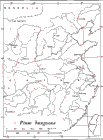
This tree grows by Jo-gye-sa, a Buddhist temple in central Seoul, South Korea. An information sign next to the tree says it is about 500 years old. It is 10 meters tall and 1.67 meters in girth at chest height. It is said that envoys going back and forth to China brought the tree and planted it here [Tom Velardi, 2004].

Bark on the tree shown above [Tom Velardi, 2004].

Foliage on the tree shown above [Tom Velardi, 2004].

Cone on a tree in the Seattle Arboretum [C.J. Earle, 2006.02.25].

Distribution map (Critchfield and Little 1966).

Pinus bungeana
Zuccarini ex Endlicher 1847
Common names
白皮松 bai pi song [Chinese]; lacebark pine; ハクショウ [Japanese].
Taxonomic notes
Syn: Pinus excorticata Lindley and Gordon (Dallimore et al. 1967).
Description
"A tree [24-30 m] high and [116 cm dbh]... Bark on young trees smooth, dull grey, scaling off in small patches like a plane tree, changing to chalky-white on old trunks, by which the species can be recognized from a long distance. Young shoots smooth, without down, greyish green. Winter buds spindle-shaped, nearly [12 mm] long, not resinous, composed of reddish brown scales. Leaves in threes, rather sparsely arranged on the branchlets, persisting three to four years, giving off a turpentiny odour when bruised, dark green, rather rigid, flattened, [5-7.5 cm] long, margins finely toothed, apex sharply pointed, faint stomatic lines on each surface; resin canals marginal and prominent; sheath soon falling away. Cones solitary or in pairs, sub-terminal but often appearing lateral by the growth of a sum- mer shoot, globose or ovoid, [5-6.5 cm] long, on short. stout stalks; scales terminated by a reflexed, triangular spine. Seed with a short, loosely attached wing." It closely resembles "P. gerardiana, from which it is distinguished by its smaller cones and stiffer leaves. From other three-leaved pines it is separated by its smooth, scaling bark, sparsely arranged foliage, peculiar habit, and the strong odour of its bruised leaves" (Dallimore et al. 1967).
Distribution and Ecology
NW China (Silba 1986). Hardy to Zone 5 (cold hardiness limit between -28.8°C and -23.3°C) (Bannister and Neuner 2001).
"[I]t was first seen by Dr. Bunge near [Beijing] in 1831. It was subsequently found in the mountains of Central China by Wilson, and is cultivated by the Chinese in the vicinity of temples and cemeteries. It grows naturally amongst limestone rocks, with widely spreading roots and branches" (Dallimore et al. 1967).
Remarkable Specimens
The oldest reported living tree was 491 years old (partially crossdated) in 2014, growing on Shennongshan in Shanxi at 1000 m elevation (Liu et al. 2019, citing Peng et al. 2014).
Ethnobotany
In Korea they are used for lumber and their seeds and oil are eaten (Tom Velardi e-mail 2004.04.18).
Observations
"In Korea, a few trees grow in such areas as Seoul, Goyang and Icheon in Gyeonggi-do, Miryang in Gyeongsangnam-do, Boeun in Chungcheongbuk-do, and Yesan in Chungcheongnam-do. The largest of these trees are designated and protected as natural monuments" (Tom Velardi e-mail 2004.04.18).
Remarks
"Lacebark pines were introduced into Korea long ago, but they do not propogate well and thus there are very few of them here. ... They are blue-grey when young, but as they mature the bark peels off and they become more and more grayish-white in color. Because of this characteristic, they are called white-pines or white-bone pines" (Tom Velardi e-mail 2004.04.18).
Citations
Liu, Jiajia, Bao Yang, and David B Lindenmayer. 2019. The oldest trees in China and where to find them. Frontiers in Ecology and the Environment 17(6): 319–22. https://doi.org/10.1002/fee.2046.
Peng J., Liu Y., and Wang T. 2014. A tree-ring record of 1920’s–1940’s droughts and mechanism analyses in Hunan Province. Acta Ecologica Sinica 34:3509–18.
See also
Elwes and Henry 1906-1913 at the Biodiversity Heritage Library. This series of volumes, privately printed, provides some of the most engaging descriptions of conifers ever published. Although they only treat species cultivated in the U.K. and Ireland, and the taxonomy is a bit dated, still these accounts are thorough, treating such topics as species description, range, varieties, exceptionally old or tall specimens, remarkable trees, and cultivation. Despite being over a century old, they are generally accurate, and are illustrated with some remarkable photographs and lithographs.
Nicholson, R. 1988. Pinus bungeana—A Ghostly Pine. Arnoldia 48(2): 32-38.
Wu and Raven 1999





